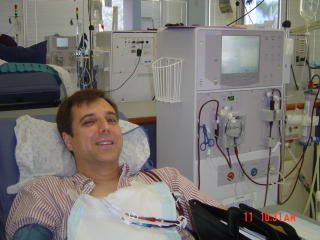About the Clinic

Folks have asked about the clinic setting. The clinic is a large open room with 20 chairs with minimal padding (read, hard) that recline. These chairs are arranged in five rows of four with a dialysis machine in between each chair. One row faces the door that opens into the clinic, but the other rows are arranged facing each other making two aisles, the staff calls two bays. My clinic is only licensed for 16 chairs; the other four are for future expansion.
Each bay has two PCT (patient care technicians) and a nurse. You can see the folks on your bay and you can talk with the folks on your bay. To talk with the folks on the ends is difficult, but you can arrange for hand signals. However, there is a point in the treatment when blood pressures drop and everyone kind of glazes over, so the conversation slows. It is also helpful to watch out for the patients. Sometimes people sink and need help from the staff. To talk to the other bay would require more volume and you cannot see the people on the other bay. The staff (techs, nurses, dietician, director of nursing, social worker, doctors) walks through the clinic checking vital signs, administering meds, checking on patients, so there is a lot of conversation with the staff.
Pictured is the machine. The red tubes have my blood in them. The blood leaves my body through an access (For right now it is a catheter in my chest. One tube is in the right atrium of my heart, and the other is spliced into my right jugular vein.) and goes to the machine, is pumped through the artificial kidney (the cylinder on the far right, is it pink colored because my blood is flowing through it as the dialysate solution is flowing counter to my blood flow so as to pull the toxins out of the blood via osmosis) and then returned to my body (colder) through the catheter. When I get my meds, the nurses just pump it into the reservoirs of blood next to the artificial kidney or they shoot it into the tubes as it comes back into my body. No more shots in the arm.
At the end of the treatment, the techs push saline (see the bag hanging top far right) through the tubes and that pushes my blood back into my body. There is only about a cup or two of blood out of my body at any given time. Once the tubes are disconnected from me, there are more procedures and shots of saline and heparin in the catheter to prevent clotting and other problems.
So, yes, there is conversation, but somewhat limited depending upon who is getting on and off the machines as well as how patients are responding to treatments.

0 Comments:
Post a Comment
<< Home